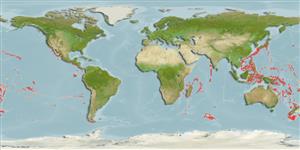Actinopterygii (ray-finned fishes) >
Anguilliformes (Eels and morays) >
Nettastomatidae (Duckbill eels)
Etymology: Nettastoma: Greek, netta = duck + Greek, stoma = mouth (Ref. 45335); solitarium: From the Latin solitarius meaning solitary, alone, lonely, in reference to the isolated and widely scattered distribution of this species in the Indo-Pacific.
Environment / Climate / Range
Ecology
Marine; benthopelagic; depth range 415 - 610 m (Ref. 40819). Deep-water, preferred ?
Indo-West Pacific: Kyushu-Palau Ridge, the Philippines, Australia, and the western Indian Ocean (Ref. 559). Reported from the Hawaiian Islands (Ref. 58302).
Size / Weight / Age
Maturity: Lm ? range ? - ? cm
Max length : 46.5 cm TL male/unsexed; (Ref. 40819)
Short description
Morphology | Morphometrics
Six supraorbital pores, SO5 present. Lateral line pores 42-45. Median vomerine teeth somewhat enlarged. Posterior nostril above anterodorsal corner of eye.
Recorded on video tape outside the coelacanth caves at a depth of 278-340 m (Ref. 58472).
Life cycle and mating behavior
Maturity | Reproduction | Spawning | Eggs | Fecundity | Larvae
Paxton, J.R., D.F. Hoese, G.R. Allen and J.E. Hanley, 1989. Pisces. Petromyzontidae to Carangidae. Zoological Catalogue of Australia, Vol. 7. Australian Government Publishing Service, Canberra, 665 p. (Ref. 7300)
IUCN Red List Status (Ref. 115185)
CITES (Ref. 94142)
Not Evaluated
Threat to humans
Harmless
Human uses
More information
Common namesSynonymsMetabolismPredatorsEcotoxicologyReproductionMaturitySpawningFecundityEggsEgg development
Age/SizeGrowthLength-weightLength-lengthLength-frequenciesMorphometricsMorphologyLarvaeLarval dynamicsRecruitmentAbundance
ReferencesAquacultureAquaculture profileStrainsGeneticsAllele frequenciesHeritabilityDiseasesProcessingMass conversion
Tools
Can't connect to MySQL database fbquizv2. Errorcode: Too many connections
